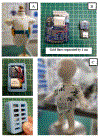Design and validation of a smart garment to measure positioning practices of parents with young infants
- PMID: 33548894
- PMCID: PMC7927978
- DOI: 10.1016/j.infbeh.2021.101530
Design and validation of a smart garment to measure positioning practices of parents with young infants
Abstract
The aim of this cross-sectional study was to evaluate the feasibility, construct validity, and reliability of a smart garment to characterize parent-child positioning practices in infants less than six months old. The smart garment (Get Around Garment, GG) was developed through feedback from seven infants and their parents. The final system was then tested with sixteen infants (M = 3.1 ± 1.1 months) assessed in their homes during one visit that consisted of a: 1) Structured Play Assessment (2.5 min): infant was placed in each of five positions (prone, supine, reclined/inclined, and upright) for 30 s, 2) Free Play Assessment (40-60 min): parents were asked to engage in typical daily activities, and 3) second Structured Play Assessment. Infants' body position was both coded from video and identified from sensor data using a custom program. Feasibility was measured by data from a Daily Wearing Log and Garment Perception Questionnaire. Validity was evaluated by comparing the coding and sensor data. Reliability was measured by comparing the sensor data between the two Structured Play Assessments. The GG was considered feasible for use. The smart wearable system showed high levels of accuracy for classifying body position secondby- second and when comparing cumulative duration across time. Reliability of the smart garment was excellent. Young infants spent more time in supine and supported upright positions relative to prone, reclined, or inclined positions. The results suggest that accelerometers can be integrated into garments in a manner that is feasible to provide accurate and consistent data about positioning practices of parents with young infants. Monitoring early positioning practices is important because these practices impact future motor and cognitive developmental trajectories.
Keywords: Accelerometer; Connected health; Infant; Parent-child interaction; Positioning; Wearable technology.
Copyright © 2021 Elsevier Inc. All rights reserved.
Figures





Similar articles
-
Infant sleep position following new AAP guidelines. American Academy of Pediatrics.Pediatrics. 1995 Jul;96(1 Pt 1):69-72. Pediatrics. 1995. PMID: 7596726
-
A deep learning-enabled smart garment for accurate and versatile monitoring of sleep conditions in daily life.Proc Natl Acad Sci U S A. 2025 Feb 18;122(7):e2420498122. doi: 10.1073/pnas.2420498122. Epub 2025 Feb 11. Proc Natl Acad Sci U S A. 2025. PMID: 39932995 Free PMC article.
-
Smart Rehabilitation Garment for posture monitoring.Annu Int Conf IEEE Eng Med Biol Soc. 2015 Aug;2015:5736-9. doi: 10.1109/EMBC.2015.7319695. Annu Int Conf IEEE Eng Med Biol Soc. 2015. PMID: 26737595
-
Posture Monitoring During Breastfeeding: Smart Underwear Integrated with an Accelerometer and Flexible Sensors.Sensors (Basel). 2024 Nov 29;24(23):7641. doi: 10.3390/s24237641. Sensors (Basel). 2024. PMID: 39686178 Free PMC article.
-
Electrode placement in electrocardiography smart garments: A review.J Electrocardiol. 2019 Nov-Dec;57:27-30. doi: 10.1016/j.jelectrocard.2019.08.015. Epub 2019 Aug 21. J Electrocardiol. 2019. PMID: 31473476 Review.
Cited by
-
Intelligent wearable allows out-of-the-lab tracking of developing motor abilities in infants.Commun Med (Lond). 2022 Jun 15;2:69. doi: 10.1038/s43856-022-00131-6. eCollection 2022. Commun Med (Lond). 2022. PMID: 35721830 Free PMC article.
-
A Contactless Method for Measuring Full-Day, Naturalistic Motor Behavior Using Wearable Inertial Sensors.Front Psychol. 2021 Oct 22;12:701343. doi: 10.3389/fpsyg.2021.701343. eCollection 2021. Front Psychol. 2021. PMID: 34744865 Free PMC article.
-
Long-form recording of infant body position in the home using wearable inertial sensors.Behav Res Methods. 2024 Aug;56(5):4982-5001. doi: 10.3758/s13428-023-02236-9. Epub 2023 Sep 18. Behav Res Methods. 2024. PMID: 37723373
-
Sitting Capacity and Performance in Infants with Typical Development and Infants with Motor Delay.Phys Occup Ther Pediatr. 2024;44(2):164-179. doi: 10.1080/01942638.2023.2241537. Epub 2023 Aug 7. Phys Occup Ther Pediatr. 2024. PMID: 37550959 Free PMC article.
-
Accelerometer Thresholds for Estimating Physical Activity Intensity Levels in Infants: A Preliminary Study.Sensors (Basel). 2024 Jul 9;24(14):4436. doi: 10.3390/s24144436. Sensors (Basel). 2024. PMID: 39065833 Free PMC article.
References
-
- Abbott AL, & Bartlett DJ (2001). Infant motor development and equipment use in the home. Child: Care, Health, and Development, 27, 295–306. - PubMed
Publication types
MeSH terms
Grants and funding
LinkOut - more resources
Full Text Sources
Other Literature Sources
Medical

